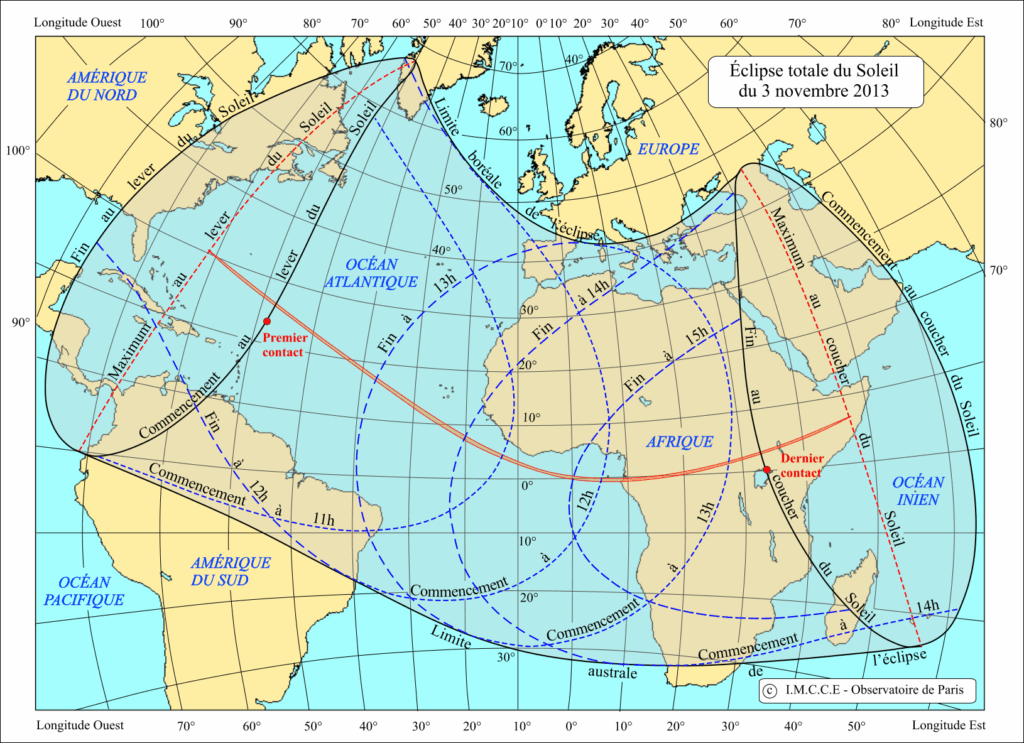The last eclipse of 2013 will occur on Sunday, November 3, 2013.
It will be a solar eclipse, with the rare feature of starting as an annular eclipse and then becoming total. It can also be seen in Italy, around lunchtime, but only – and very partially – in the South.
General visibility
The line of centrality (the narrow band on the Earth’s surface where all phases of the eclipse can be observed) will start near the coast of Florida, then cross the Atlantic Ocean and end in central Africa, passing through Gabon, Congo, Uganda, Kenya, Ethiopia, and Somalia. Overall, the total phase will last more than three hours.
The phenomenon will also be observable as a partial eclipse from the easternmost regions of North America and the northernmost regions of South America, from almost the entire African continent, the Middle East, Spain, Greece, and, as mentioned, southern Italy.

Visibility in Italy
The line marking the northern limit of the eclipse crosses the Tyrrhenian Sea, passing through the Strait of Bonifacio and intersecting lower Lazio, so only the regions below this line (Basilicata, Campania, Puglia, Calabria, Sicily, and Sardinia) will be affected by the phenomenon.
The visibility will be quite modest. Paraphrasing the title of a recent film, for our skies, it will be a “small southern eclipse.” On average, the fraction of the solar disk that will be eclipsed in these locations will range from one to two percent. Only in Lampedusa will a higher percentage be reached. In practice, a very small dark notch will be seen on the lower edge of the Sun.
In Cagliari, the phenomenon will last about 50 minutes from 13:42:06 (local time) to 14:32:38. The maximum (eclipsed percentage equal to one percent, see figure) will occur at 14:07:32. The Sun will have an altitude of 29° above the horizon, to the southwest. More or less the same times but even lower percentages in the rest of Sardinia.
Total, Annular-Total, or Hybrid?
The eclipse on November 3 has an almost unique characteristic, and its classification has divided experts. Initially, it will appear – for a very short time – as annular (the lunar disk will appear centered on the solar one but without completely covering it) and then become total for the rest of the eclipse (with the solar disk completely obscured).
The conditions that give rise to a solar eclipse are the perfect alignment of the Moon (new) with the Sun-Earth direction, but whether an eclipse is annular or total depends essentially on the apparent size of the lunar disk, which, being a function of the distance of our satellite from us, varies over time, mainly due to the ellipticity of the lunar orbit.
In general, if the lunar disk appears smaller than the solar one, an annular eclipse will occur; if larger, a total eclipse will occur. In some, albeit infrequent, borderline cases, the variations in the Moon’s position along its orbit and the Earth’s rotation during the eclipse can give rise to what astronomers call a hybrid eclipse, that is, an eclipse that can be seen as annular in some places of the centrality band, become total in others, and then return to annular. Since the behavior of the eclipse on November 3 has similarities but does not strictly follow this alternation pattern, some authors have preferred to classify it simply as annular-total rather than hybrid.
PRACTICAL TIPS AND RECOMMENDATIONS
It is always important to remember – and especially for this eclipse – that the bright part of the Sun remains dazzling and dangerous for the retina, so direct viewing of the Sun without adequate protection must be absolutely avoided.
Sunglasses or filters made with homemade methods should be categorically avoided because they do not offer sufficient shielding and because any defect or imperfection could allow sunlight to pass through, causing the same damage to vision. It is possible to use welder’s mask glass with a grade equal to (or greater than) 14, available in hardware stores. When using binoculars or a telescope, it is recommended not to bring the eye close if the instrument is not protected by an adequate filter. If a good quality filter is not available, it is advisable to roughly point the binoculars at the Sun and project the image onto a white sheet of paper placed about a meter away.
UPCOMING EVENTS
To observe another solar eclipse in Italy, we will have to wait until March 20, 2015 (a partial eclipse but with a magnitude greater than 0.5) and then June 21, 2020, an eclipse that will be very small and visible only in the southern regions, including Sardinia.
The next total eclipses on Italian territory are expected on August 2, 2027 (territorial waters around Lampedusa), September 3, 2081 (northeastern Italy), July 6, 2187 (central Italy), and November 8, 2189 (southern Sicily).
We will also have to wait until 2015 to observe a lunar eclipse from Italy. None of the two eclipses scheduled for 2014 will be visible in our country.